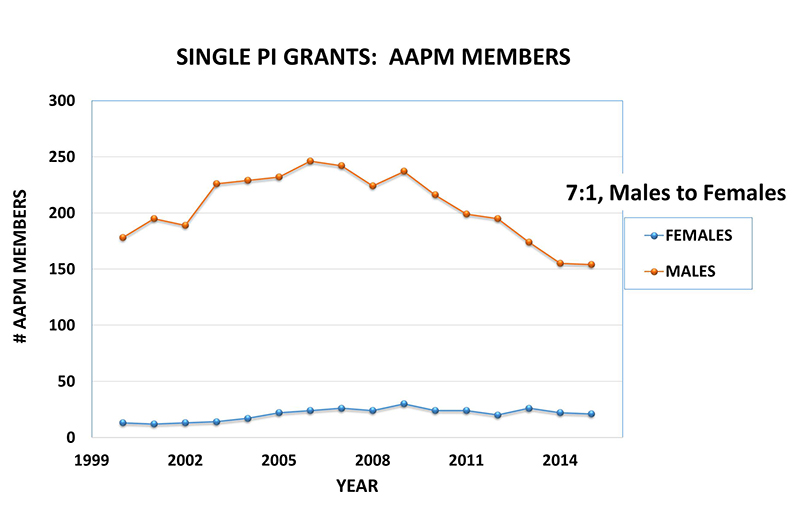Recently, the AAPM Working Group for the Development of a Research Database (WGDRD) embarked on an important initiative to identify Full AAPM members who are funded by the National Institutes of Health (NIH) (1). The NIH is the largest public contributor of biomedical research and is the primary funding source for investigator-initiated research. Importantly, the WGDRD found that the overall funding rates of AAPM members actually accounted for a very small portion of the NIH budget. For example, in 2015, the National Cancer Institute (NCI) had an annual funding budget of ~$5B, although only 1.2% of the budget was allocated to AAPM member grants(1). After reading the WGDRD's article, a key finding that piqued my interest was that only 11% of the grants held by AAPM members are held by female members — 11%. As a female Principal Investigator (PI) on an NIH R01 from the NCI, I was floored by this number. With the support of WGDRD, I took a deeper dive into the demographics, potential contributors, and strategies that we (as physicists and as an organization) may consider to support Women in Research, Education, and Development (WIRED, for short).
So just how many female AAPM members do we have, and how many qualify to apply for an NIH grant? In 2015, the AAPM membership was ~22% female, however the NIH requires PIs to have a "terminal research degree," suggesting that a PhD is required. There were ~5 times as many male as female AAPM Full members with a PhD (~2,200 to 450, respectively). Nevertheless, in 2015, males were awarded NIH grants as PIs seven times more than females (155 vs. 22, respectively). Figure 1 highlights that while the number of male PIs has been variable over the past 15 years (ranging from 154 to a high of 246 in 2006), the number of female PIs has remained low and fairly steady (13-30 grants awarded). One confounder is that data are sparse on the number of grants submitted by females vs. males, so it is currently unclear if males are simply applying more frequently. Furthermore, males were six times more likely to serve as a PI on a multiple PI grants than females (22 and 4, respectively).
 Figure 1: Single Principal Investigator (PI) grants awarded to AAPM members by the National Institutes of Health. Data source: (1).
Figure 1: Single Principal Investigator (PI) grants awarded to AAPM members by the National Institutes of Health. Data source: (1).
Aside from the number of grants awarded, evidence suggests that a significant funding gap exists between males and females with respect to the average size of their awards (2). From 2002 to 2012, while an increased number of NIH grants nationally were awarded to women (24% to 30%), the average grant size was only 83% of those awarded to males. This suggests that females may also be requesting less (or are just being awarded less) than their male counterparts.
The WGDRD has put forth as a recommendation in their publication that AAPM "must consider developing mechanisms that better encourage and support female members applying for research funding."(1) This recommendation is fully supported by the data that suggests an opportunity exists to improve our odds for NIH grant funding, not only for females, but for males as well. Potential avenues include: to develop a formal mentorship program to assist in grant development, for AAPM to commit some resources to hold grant writing workshops, and to develop additional seed funding mechanisms intended to facilitate preliminary data generation, perhaps with an emphasis on addressing the gap in female funding. AAPM currently offers three $25,000 Research Seed Funding Grants annually, with the intent of developing "exciting investigator-initiated concepts, which will hopefully lead to successful longer term project funding from the NIH or equivalent funding sources." Since 2005, AAPM has awarded $550,000 to this initiative. However, during this time frame, only 3 out of 22 of these awards have been awarded to female AAPM members.
In summary, a great opportunity exists to increase the amount of NIH funding for all AAPM members, and especially for females. For our AAPM members who have been fortunate enough to receive NIH funding, please consider mentoring others, sharing your wisdom, and providing examples that you are comfortable sharing with new investigators. For those of you who are interested in becoming a PI, start writing grants early in your career (e.g., predoctoral and postdoctoral fellowships) and study the "art" of grant writing via webinars and seminars such as those offered from RSNA. The road to grant funding is never easy; you can view my personal narrative (and excessive consumption of chocolate ice cream related to that endeavor!) in the AAPM Virtual Library. Overall, if we invest the time and resources needed to generate competitive grant proposals—and we keep applying—we can only increase our chances of success!
We have noticed that you have an ad blocker enabled which restricts ads served on this site.
Please disable it to continue reading AAPM Newsletter